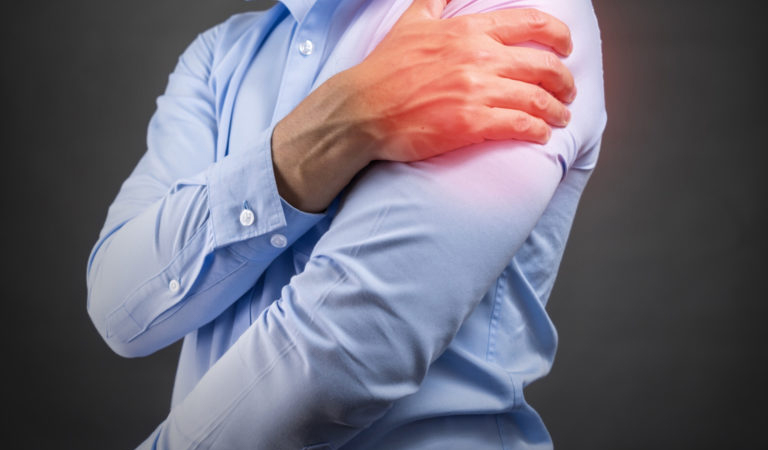
One of the most nagging, life-altering pains is shoulder pain, affecting every movement and every moment in your day. Shoulder pain is often constant and debilitating, and can leave those afflicted feeling hopeless.
If you suffer from shoulder pain, we can help you.
Anatomy of the Shoulder
The shoulder is one of the more unique anatomical structures of the human body made up of several layers: thick connective tissue, nerves, tendons, ligaments, muscles, bones and joints. Where the upper arm (humerus), collarbone (clavicle) and shoulder blade (scapula) meet, the shoulder is one of the only two ball-and-socket type joints in the body, the other being the hip joint. Because of this ball-and-socket anatomy, the shoulder joint provides for a particular form of articulation which allows us to move our arms in many different directions.
Joints of the Shoulder
Commonly thought to be just one joint, the shoulder is actually made up of four joints:
- Glenohumeral joint – considered the most mobile and least stable joint of the body, and the major joint in the shoulder. It is where the top of the humerus fits within the socket (glenoid fossa) of the scapula.
- Acromioclavicular (AC) joint – the acromion is the most superior portion of the scapula, making the “top” of the shoulder, and where the clavicle (collar bone) meets the scapula.
- Sternoclavicular (SC) joint – where the clavicle meets the chest bone (sternum).
- Scapulothoracic joint – where the scapula meets the ribs at the back of the chest
This remarkable combination of bones within the structure of the shoulder is held together with an intricate network of connective tissue, and tendons, connecting bones to muscle, and ligaments, connecting bones to bones. Working together, the connective tissues, bones, tendons and ligaments of the shoulder joint provide both incredible flexibility and mobility. Because of its unique anatomy and function, the shoulder joint is also vulnerable to wear and tear, deterioration or injury.
SLAP Tears
One of the more common injuries of the shoulder is a tear to the connective tissue (labrum) providing support within the inner portion of the shoulder joint, known as a SLAP tear. SLAP is an acronym for Superior Labral tear from Anterior to Posterior, and can easily develop from over-time repetitive movements, aging, or injury. This is the area of the shoulder wear the biceps tendon inserts. A tear to the labrum can be very painful.
There are several types (or classifications) of SLAP tears, including:
- Type I SLAP – fraying at the top of the labrum, usually due to the aging process.
- Type II SLAP – the most common SLAP type, the labrum has detached from the top of the main shoulder joint, usually caused by wear-and-tear or injury
- Type III SLAP – a bucket-handle tear of the labrum, drooping into the shoulder joint, usually caused by trauma
- Type IV SLAP – a specific tear to the top of the labrum, usually involving tendons and caused by trauma
SLAP Symptoms
SLAP tears are very unique in their manifestation, and, consequently, just as unique in their symptoms. Not all SLAP tears hurt all the time, and the pain usually presents when you are performing a task, such as reaching overhead.
Symptoms may also include:
- A grinding feeling
- Sensation of popping, locking or “catching”
- A feeling the shoulder is going to “pop out of joint”
- Instability in the joint
- Loss of strength and/or range of motion
- Pain with movement or in a specific position
- Constant or intermittent pain
Diagnosis
Just as there are many ways to injure or tear the labrum, there are just as many places where the tear may occur, making the symptoms very similar. Because of this, diagnosing the SLAP tear may be just as complicated.
Generally, the diagnostic process will include:
- A detailed medical history of symptoms, pain level, and exact area of pain
- A thorough physical exam of the shoulder, including analysis of the range of motion of the arm and shoulder
- Medical imaging, such as X-Ray or MRI
Treatment Options
Depending on the cause and type of the SLAP tear, treatment options may include:
- Over the counter or prescribed anti-inflammatory medication
- A regimen of icing and rest
- Specific exercises or physical therapy
- Arthroscopic surgery to trim, reattach or repair the labrum
- Detachment and reattachment of the biceps tendon
Because each patient is different, shoulder joint pain and the treatment options are just as varied. Shoulder pain can be very difficult to live with, and at Orthopaedic Medical Group of Tampa Bay, we have experts in the field of arthroscopy and sports medicine who are ready to help patients return to a pain-free and normal lifestyle. Please call 813-684-2663 (BONE) or visit this page to make an appointment and let our highly skilled team of medical professionals help you.

Dr. Edward H. Becker is a Subspecialty Certified Sports Medicine Surgeon and General Orthopaedic Specialist. He earned his B.S. degree in biological sciences from the University of Maryland, Baltimore County and his MD from University of Maryland School of Medicine. After medical school, Dr. Becker continued his training as a resident in the Department of Orthopaedic Surgery at the University of Maryland Medical Center and R Adams Cowley Shock Trauma Center. After completion of his residency, Dr. Edward Becker elected to further his training in Sports Medicine and was selected to do a fellowship at the world renowned Kerlan-Jobe Orthopaedic Clinic in Los Angeles, California. He has worked with numerous college athletic programs and professional teams including the world champion Los Angeles Kings, Los Angeles Lakers, Los Angeles Dodgers, Los Angeles Sparks, Anaheim Angels, Anaheim Ducks. Dr. Becker has been with the Orthopaedic Medical Group of Tampa Bay since 2013. Full Bio




